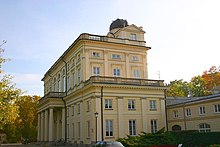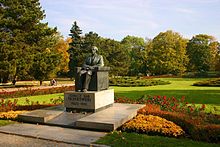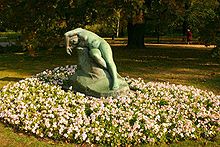Ujazdów Castle
| Ujazdów Castle | ||
|---|---|---|
|
Garden facade |
||
| Creation time : | before 1100 | |
| Castle type : | lock | |
| Conservation status: | Reconstructed | |
| Place: | Warsaw | |
| Geographical location | 52 ° 13 '10 " N , 21 ° 2' 15" E | |
|
|
||
The Ujazdowski Castle (actually Ujazdów Castle; Polish Zamek Ujazdowski ) is located in the Polish capital Warsaw on the Aleje Ujazdowskie , part of the Warsaw Royal Route . Located south of the city center, it is surrounded by extensive parks.
Jazdów settlement
Originally there was a medieval castle of the Dukes of Mazovia called Jazdów on the site . A settlement developed around this castle, which was destroyed by the Lithuanian King Mendog around 1265. The Jazdów settlement was built on a hill above the Vistula after the settlement in Brody was destroyed in the 11th century. After the destruction of Jazdów, Warsaw craftsmen and merchants settled further north, in the area of today's Old Town. In the area of the Ujazdów Castle ( Castle near Jazdów ) a small hunting lodge was built, which was later expanded to become the Ujazdów Palace.
Ujazdów Castle
The hunting lodge was expanded by King Zygmunt II. To a royal palace, in which his mother Queen Bona Sforza lived temporarily after the death of her husband Zygmunt I. From 1620 to 1624 Zygmunt III. convert Matteo Castello's castle into a baroque fortress with a square inner courtyard. In 1683 Crown Marshal Lubomirski acquired the castle and had it redesigned. One of the architects involved was Tylman van Gameren . The last Polish king, Stanisław August Poniatowski , acquired the castle in 1764 and transferred the land to the city of Warsaw in 1784.The castle and its ancillary facilities initially served as barracks and in the following almost 150 years up to the Second World War as a military hospital. It was set on fire by the Wehrmacht during the German occupation of Poland and 40% of it was destroyed. After the war it was not rebuilt, but its remains were removed in 1954 on the orders of the then Marshal Rokossovsky . The Polish Army Theater was to be built in its place. It was only reconstructed in 1975 in the original, early baroque style.
Center Sztuki Współczesnej Zamek Ujazdowski
In 1981 it became the seat of the ambitious Center for Contemporary Art (Polish Centrum Sztuki Współczesnej Zamek Ujazdowski ). Contemporary visual arts, music and theater, film and video are the subjects of exhibitions and artist workshops.
Agrykola Park
The Agrykola Park surrounds the Ujazdów Palace and connects to the south of the Ujazdów Park and north of the Łazienki Park . To the west of the castle is the Piaseczyński Canal, several hundred meters long, which, equipped with a fountain, leads towards the bank of the Vistula .
Botanical Garden
Between the Agrykola Park and the Łazienki Park is the Botanical Garden, which was laid out by the University of Warsaw at the beginning of the 19th century and is now home to over 7,000 plants. Michał Szubert created it from 1817 to 1819 on the site of an earlier English park . In addition to the observatory, the foundations of the originally secular Temple of Divine Providence are also located here, the construction of which began in 1792 under Jakub Kubicki in honor of the constitution of May 3, 1791 . After the second partition of Poland in 1793, construction was stopped. In 2017, a new Temple of Divine Providence (Świątynia Opatrzności Bożej) was dedicated instead , a modern building in Miasteczko Wilanów , now a Catholic Church.
Ujazdów Park
Ujazdów Park was created by Franciszek Szanior between 1893 and 1896. The park covers an area of almost 6 hectares and is connected to the Ujazdów Castle, the Agrykola Park and the Łazienki Park in the north. The fork in the road ( Plac na Rozdrożu in Polish ) is located at the intersection of the three parks. In the west they are bordered by the Aleje Ujazdowskie . In the park there was once an Orthodox church by an artificial lake. Today, the park several monuments, "The Bridge" by William Lindley , the " scales " of 1898, the " Gladiator " by Pius Wieloński from 1892, the statue "Eve" by Edward Wittig (1930), the Paderewski -Denkmal Michał Kamieński from 1938 and “ Perseus ” by Theodor Charles Gruyer from 1972.
Other parks in Warsaw
- Warsaw Royal Route
- Saxon garden
- Krasiński Park
- Gardens of the Royal Castle
- Wilanów Palace
References and comments
- ↑ The Polish adjective form (here: Ujazdowski ) is often adopted in German






